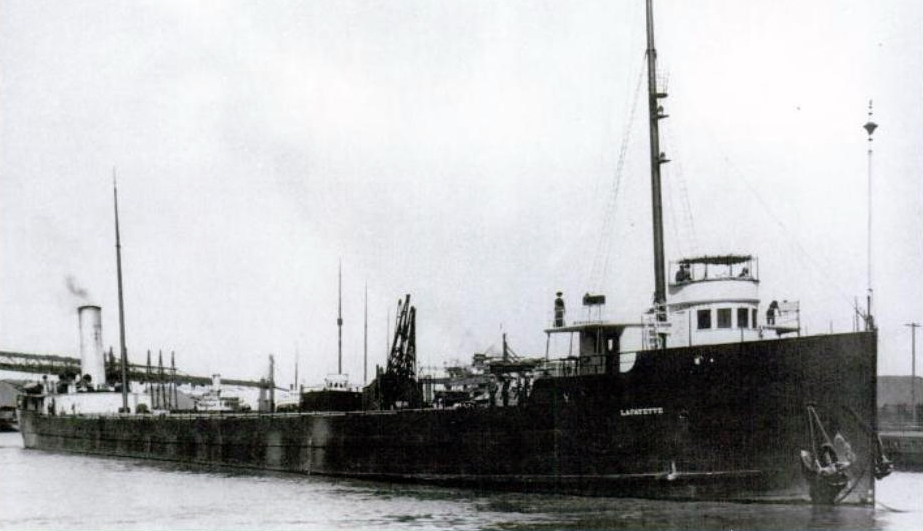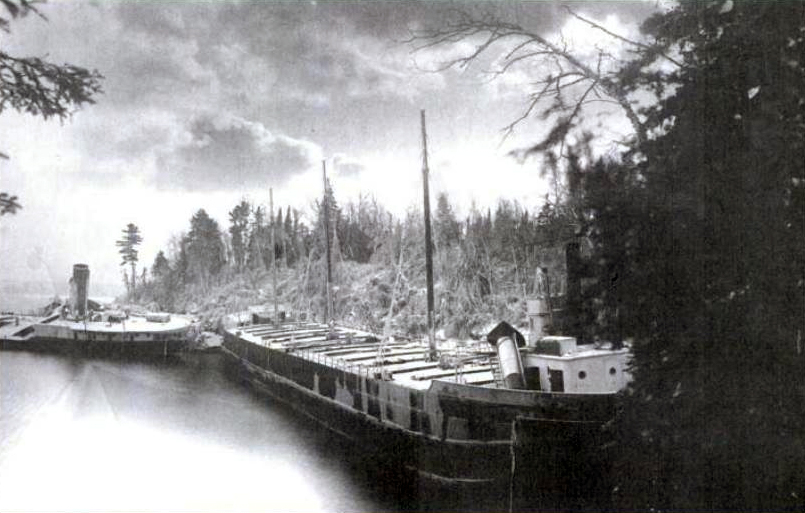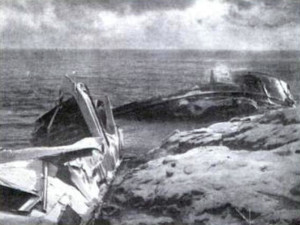The Gales of November: Lafayette Shipwreck
One of the earliest victims of the big blow on Lake Superior in November of 1905 was the steamer Lafayette and her barge, the Manila. After passing through Soo, the Lafayette was caught west of Devil’s Island when the great storm started churning the lake into an uproar. After fighting the storm for several hours and traveling at half-speed, Captain Dell Wright was hoping to see the lighthouse on Devils’ Island to regain his bearings. Captain Wright’s years of experience gave him only a rough idea of his ship’s location, and he had an important decision to make. Knowing the western end of Lake Superior was narrow, and that the storm had blown him several miles off course, Wright needed to decide whether to stay the course toward Minnesota and its sharp, craggy shoreline, or change course and hope that in the event the ship was run aground, it would be onto the soft, sandy beaches of the Wisconsin coastline.
The Lafayette was one of the first ships built by the Pittsburgh Steamship Company to carry iron ore from the north shore of Minnesota to the steel mills of the eastern great lakes. Built in 1900 at a cost of $300,000, she was part of the “college line” of ships; a group of five steamers painted identical to one another and named after colleges attended by Pittsburgh Steamship executives (other ships in this fleet were Cornell, Harvard, Princeton, and Rensselaer). The Lafayette was a behemoth in her time–she grossed 5,113 tons and was 454-feet long. Her modern steam engine was capable of 1,800 horsepower. Her partner for this trip was the 436-foot barge, Manila, which had a gross tonnage of 5,039. Together, they set out empty from Ohio for the last run of the season.

It was just after 10:00 p.m. on November 28, when Captain Wright decided it would be best for his ship and crew to change course. Fearing that the storm would worsen through the night, the sandy shoreline around Superior, Wisconsin would be the best place to ride out the blow. The wind and waves repeatedly lifted the steamer up and tossed her back down. Each time, the compass would move seven or eight points. The wheelman struggled to bring the ship back onto its proper course. It was impossible to get a bearing, and after several hours they could only guess at their location. Adding to the trouble, the Manila was flailing wildly at the end of the tow line. One minute the Lafayette crew would see the Manila come along side her on the starboard side, then a few moments later the Manila would appear next to them on the port side. Captain Wright tried in vain to bring his ship about and point it into the wind, but the laboring steamer and barge would get stuck in the troughs of the waves. Through it all, Wright still believed he was on a course to Superior.
Around 5:00 a.m. on November 29, the exhausted crew heard the dreaded and unmistakable roar of waves breaking in shallow water. Captain Wright immediately ordered the helm be put hard over, but it was too late. The thunderous waves shoved the steamer into the shallow water, and the next sound the crew heard was steel being ripped apart by the sharp rocks near the shore. The Lafayette ground to a halt about fifty feet from the heavily wooded shore. The Manila roared through the rocks in the same fashion before slamming into the steamer’s stern and then swinging broadside to the shore. The pounding surf quickly ripped the Lafayette apart – the immense waves picked her up and tossed her back against the rocks from twenty or thirty feet. Each time, the steamer would strike the rocks with a crash that could have been heard for miles. After the third crash against the cliffs, she broke in two. Her stern swung into a little cove while the forward part continued to be beaten against the rocks.

Nearby, the lighter Manila was pushed closer to shore when she ran aground. Her Captain, George Balfour, ordered the crew to scuttle her so it would fill with water and settle to the bottom. Once the barge was stabilized in the shallow cove, her crew, along with four men from the Lafayette who had jumped onto the barge when it rammed the steamer, gathered on deck. They were able to grab tree branches that hung over the deck and climb over them to the safety of the shore. The men then raced to the stern section of the Lafayette and establish a line from the stern to the shore for the crew to climb across. Once the line was secured around a large tree, the crew from the stern of the Lafayette pulled themselves one at a time to the shore. The blustery wind stung their faces and numbed their hands as the waves rocked the stern causing the line to alternate between being pulled taught and then being slack. Only one man, fireman Patrick Wade, was lost while trying to make the crossing. Next, the survivors went to the bow of the ship to help the men stranded there, including Captain Wright. The crew from the bow had begun climbing up the rocky cliff as waves crashed against it. All of the men made it to the top of the cliff where the rest of the crew was waiting.
Neither Captain knew where they were. The entire crew was bruised, wet, and inadequately clothed for the bitter temperatures. They set off into the woods looking for a cabin or barn to shelter them until daylight and the possibility of a rescue. However, they didn’t know that they were on a remote stretch of wilderness six miles east of Two Harbors, near Encampment Island. After spending an hour wandering through the woods, the men returned to the wreck site and built a large bonfire for warmth. Shortly after midday, the tugboat Edna G steamed past looking for survivors. Although the crew was spotted, the rocky cliff and crashing waves prevented a rescue. The crew was forced to spend forty-eight hours in the woods with only a fire to keep them warm before a rescue could be attempted. Six of the men were hospitalized in Two Harbors due to frostbite and hypothermia, while the rest of the crew were taken to Duluth to speak to the authorities about their ordeal.

Weeks later, the barge Manila was pulled from the rocks and repaired. She continued to carry cargo back and forth across the lakes until 1956. The Lafayette was in far worse shape and considered a total loss. The stern was all that remained of the huge ship. Eventually, it was towed to Duluth where the engine was salvaged and placed into a brand new steamer, the J.S. Ashley. Small pieces of the wreckage can still be seen by divers. The debris sits in ten to twenty feet of water just off the shore. There is no land access to the site, visitors must reach the location of the wreck by boat (GPS coordinates 47º05.695’N, 91º32.961’W.)
